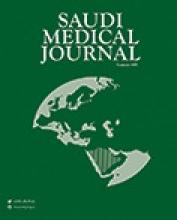Abstract
OBJECTIVE: This descriptive study was carried out to determine the clinical and epidemiological pattern of systemic sclerosis in Iraqi patients who prove to have the disease.
METHODS: Between March 1997 and December 1999, 75 patients, 67 females and 8 males, were studied at 2 teaching hospitals in Baghdad, Iraq. The diagnosis of the disease was based on clinical findings, biochemical, serological, and pulmonary function tests.
RESULTS: All the patients had Raynaud's phenomenon, 72 (96%) had arthralgia, 65 (87%) had dysphagia, 62 (83%) had atrophic changes or hypo/hyperpigmentation, 43 (58%) had telangiectasia, and 3 (4%) had subcutaneous calcification. Of the patients studied, 2 patients (3%) had hypertension, one had severe hypertension. Twenty-three patients (31%) had anemia, 58 (77%) had elevated erythrocyte sedimentation rate and 7 patients (9%) with renal impairment. Rheumatoid factor was positive in 17 patients (23%) and antinuclear antibody in 50 (67%). Abnormal chest x-ray was reported in 50 patients (67%). Pulmonary function tests showed restrictive pattern in 53 (71%) patients and obstructive pattern in 3 (4%). Electrocardiogram changes were seen in 3 (4%) of the patients. Three juvenile cases were reported, and familial tendency was noted in one patient. The results were compared with other studies and there were interesting differences and similarities.
CONCLUSION: Systemic sclerosis is a rare disease in Iraq, nevertheless sporadic cases at a peak age of 20-40 years were reported. Generally the clinical picture was comparable to other studies, however Raynaud's phenomenon is more prevalent in our patients and antinuclear antibody is less common.
- Copyright: © Saudi Medical Journal
This is an open-access article distributed under the terms of the Creative Commons Attribution-Noncommercial-Share Alike 3.0 Unported, which permits unrestricted use, distribution, and reproduction in any medium, provided the original work is properly cited.






